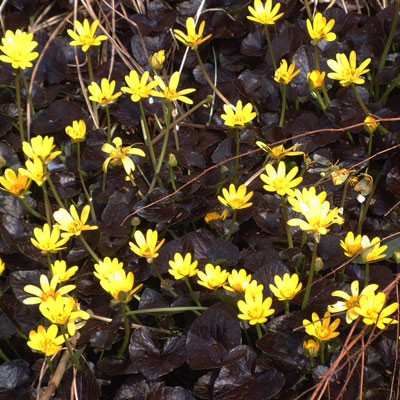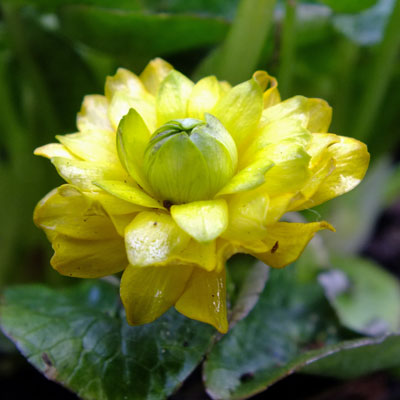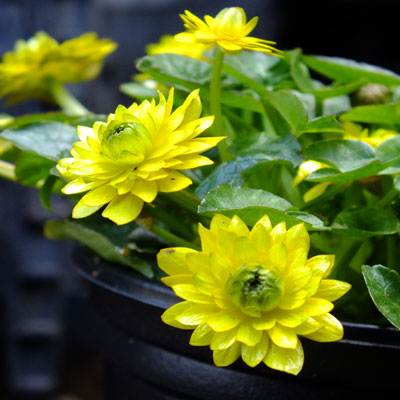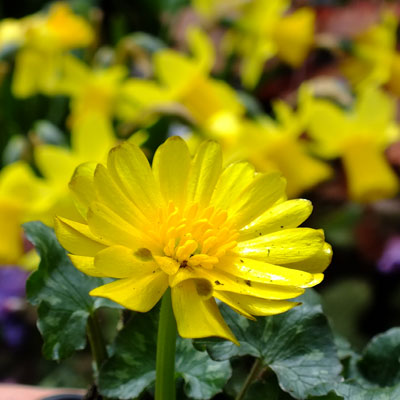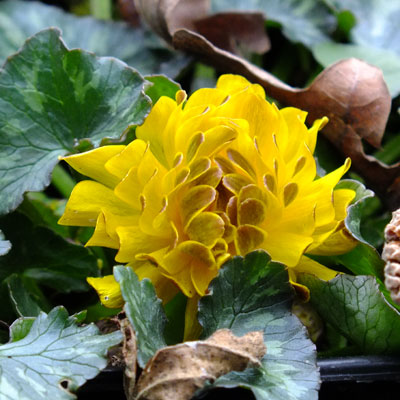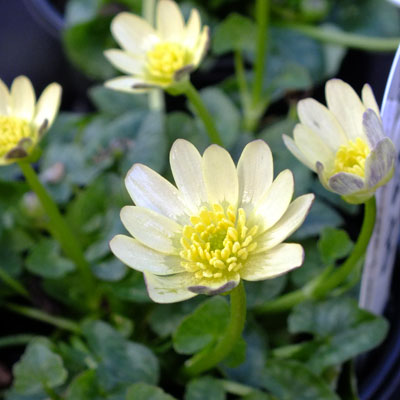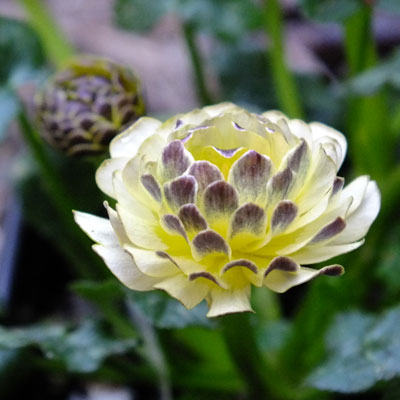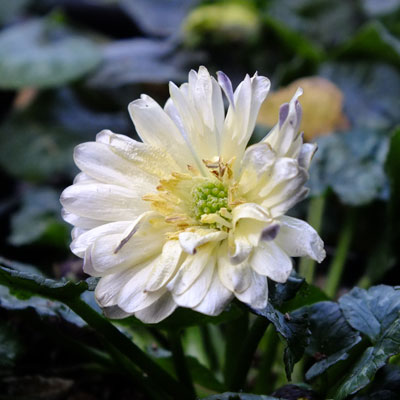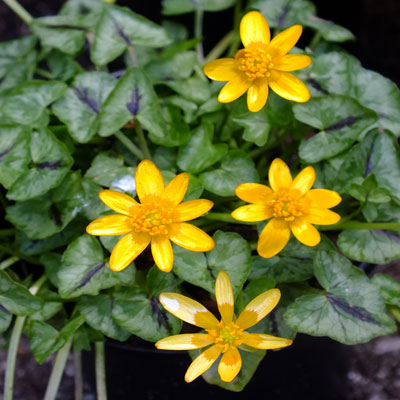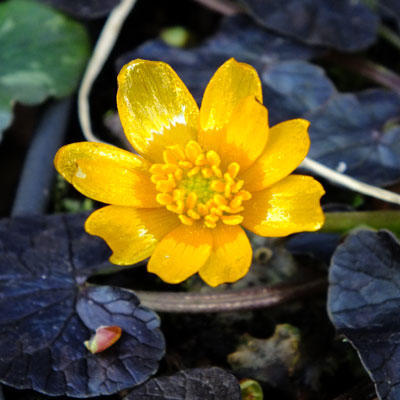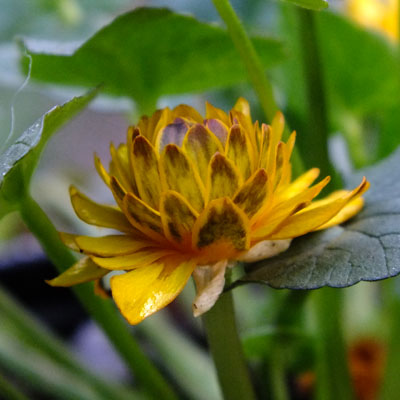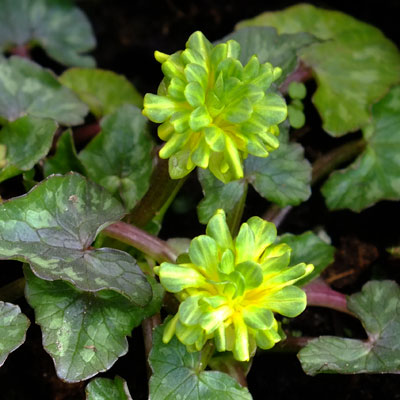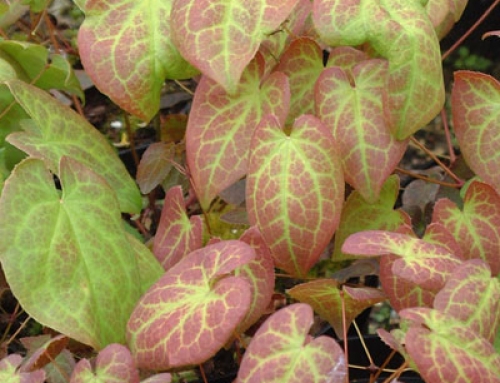Below are all of our Celandines arranged for easy comparison
Single Yellow
Lesser Celandine. Perfect heart-shaped shiny black leaves that show through green patches if you hold them up to the light. They are a perfect backing for the big, bold, blunt ended glossy celandine flowers that shine out so brightly in the cold late Winter. She is not called Ficaria verna ‘Brazen Hussy’ (Ranunculus ficaria) for nothing, but like her namesake she has plenty of brash charm to spare. Found by Christopher Lloyd’s mother whilst out on a walk in the woods one day.
Double Yellow
An anemone centred celandine . Bright golden yellow with widely spaced rounded petals around a tight central boss of curved petaloid stamens. The leaves are a joy for they are variously marbled and splashed with green, black and pewter. Sterile. Probably selected at Myddleton House, the garden of EA Bowles. Propagated by P Corbis in Yelverton in the 1960’s as Beamish Double
Lesser Celandine. Ficaria verna Flore Pleno Group (Ranunculus ficaria) is a real little cracker with endlessly double flowers in quite a lemony yellow with a lime green centre. The glossy petals are stacked up row upon row with a beautiful regularity and grace. With no central stamens they are reminiscent of Water lilies and of the flowers of Ranunculus constantinopolitanus Plenus. Plain green leaves. A very old sterile cultivar, first propagated in 1670 by John Rea
Lesser Celandine. Gold-edged, bronze buds open to a typical celandine colour, the difference being that Ficaria verna ‘Montacute’ (Ranunculus ficaria) has 4 ruffs of petals, prettily incurved to reveal the contrasting bronzy reverse. The petals are neatly square-ended, almost as if they have been trimmed. Unlike ‘Flore Pleno’ the centres of the flowers are open revealing a green eye surrounded by a boss of orange anthers. The leaves are arrow shaped, green flecked with silver. A favourite of mine and one of the earliest to flower. Said to have been rescued from a verge in Montacute, Somerset in 1994 just prior to being destroyed in roadworks.
Single White
Lesser Celandine. Ficaria verna Randall’s White’ (Ranunculus ficaria) has glossy Buttermilk petals, shaded purplish on the reverse set off by a central boss of double-cream stamens. A nice contrast to the other cultivars or where the bold yellows are a bit too strident. Plain green leaves. This selection comes from Allan Robinson, former Rock Garden Superintendent at Wisley, who named it after his cat.
Double White
Very distinctive. The large very double flowers are creamy white with short petals that curve inwards to reveal strongly ruby reverses. Leaves are mid green marked paler and have distinctive rolled and waved edges. Discovered by Ruby Baker.
Fully double blooms of a nice water lily shape which are creamy yellow with a distinct blue-grey reverse. Plain green leaves. Long stemmed. Named by RHS botanist Dr Alan Leslie.
At least 4 rows of incurved petals that are pale cream with a violet flush on the reverse. The centre of the flower glows yellow from the stamens. Leaves are a dark green with paler flecks. Discovered at Wisley by RHS gardener Graham Joseph Luerden.
Whilst the lovely double flowers are creamy white, the interior glows limey green, intensified by the violet flush to the reverse of each petal. Similar in flower to ‘Sylvie’. Leaves are a good mid green with paler flecks. Found at RHS Wisley by botanist Dr Alan Leslie and named in honour of a former head of the rock garden. Produces a mixture of sterile and fertile flowers
The heavily double flowers are creamy white, but glow with a pale yellow green interior, greener when young. Similar in flower to ‘Ken Aslet Double’. The slight violet flush on the reverse helps to mark out each individual petal. The leaves emerge a deep black purple with pale marginal flecks and fade rich green with black flecks towards the centre. Raised by Joe Sharman.
Single Orange
Lesser Celandine. Ficaria verna Aurantiaca Group (Ranunculus ficaria) has mahogany buds opening to neatly shaped, bright glossy orange flowers. Each one has a darker, matt orange central disc and a strong coloured orange boss of stamens. As the flowers age the petals spread and the central disc becomes more prominent whilst the petal colour fades. Arrow-head shaped leaves are green, overlain with pewter and marked with a central black splash.
Lesser Celandine. Ficaria verna ‘Coppernob’ (Ranunculus ficaria) has dark, near black foliage contrasts heavily with the dark green stems carrying shining orange flowers to cheer the cold of Late Winter. Each flower has a central boss of orange stamens that open to reveal a green eye. Similar to ‘Brazen Hussy’ except for having darker flowers. Leaves can be lobed at the base in a similar fashion to Hepatica
Double Orange
The fully double flowers are orange, with the centre of young flowers flushed both darker and with green. The reverse of each flower in flushed red. Deep rich plum purple leaves. Raised by Joe Sharman. Almost all the flowers are sterile.
The beautifully shaped insensely orange flowers of this variety have a rusty reverse and sometimes have a little green button eye. It is a shame the stems are so short so as to keeep the flowers nestled amongst the green, silvery spotted leaves. Raised by Joe Sharman.
This showy little Ficaria has nice long stems supporting very large, double pale orange celandines with darker reverses which glow in the sunshine. It is a fertile variety raised by joe Sharman.
Oddities
This curious little variety produces fully double blooms of shiny green flowers, streaked with yellow. Definitely a curiosity for the collector who likes to ‘have the set’ !


















































